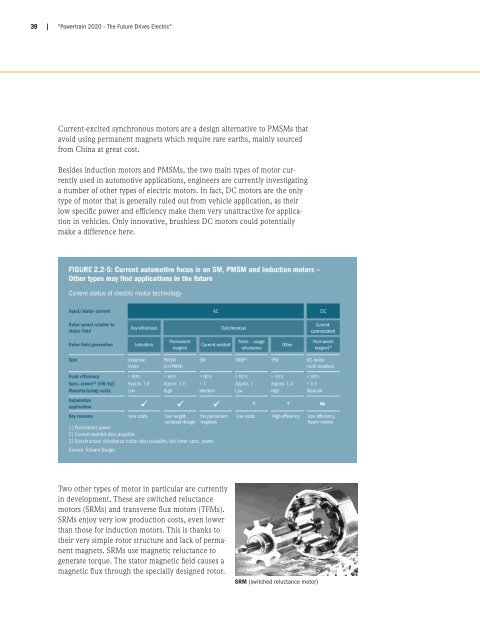Powertrain 2020 - The Future Drives Electric (PDF ... - Roland Berger
Powertrain 2020 - The Future Drives Electric (PDF ... - Roland Berger
Powertrain 2020 - The Future Drives Electric (PDF ... - Roland Berger
You also want an ePaper? Increase the reach of your titles
YUMPU automatically turns print PDFs into web optimized ePapers that Google loves.
39 |<br />
"<strong>Powertrain</strong> <strong>2020</strong> – <strong>The</strong> <strong>Future</strong> <strong>Drives</strong> <strong>Electric</strong>"<br />
Current-excited synchronous motors are a design alternative to PMSMs that<br />
avoid using permanent magnets which require rare earths, mainly sourced<br />
from China at great cost.<br />
Besides induction motors and PMSMs, the two main types of motor currently<br />
used in automotive applications, engineers are currently investigating<br />
a number of other types of electric motors. In fact, DC motors are the only<br />
type of motor that is generally ruled out from vehicle application, as their<br />
low specific power and efficiency make them very unattractive for application<br />
in vehicles. Only innovative, brushless DC motors could potentially<br />
make a difference here.<br />
Two other types of motor in particular are currently<br />
in development. <strong>The</strong>se are switched reluctance<br />
motors (SRMs) and transverse flux motors (TFMs).<br />
SRMs enjoy very low production costs, even lower<br />
than those for induction motors. This is thanks to<br />
their very simple rotor structure and lack of permanent<br />
magnets. SRMs use magnetic reluctance to<br />
generate torque. <strong>The</strong> stator magnetic field causes a<br />
magnetic flux through the specially designed rotor.<br />
SRM (switched reluctance motor)

















